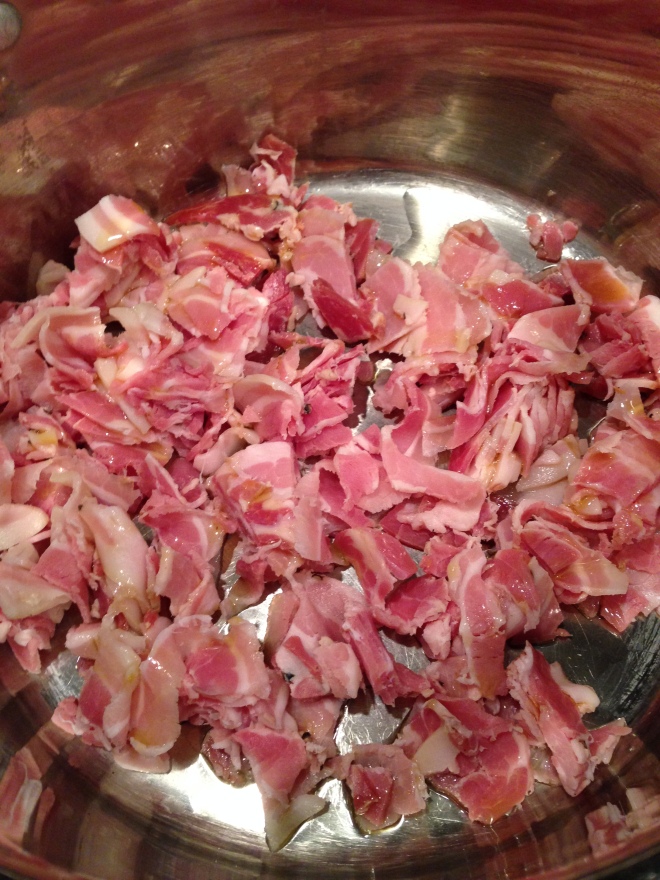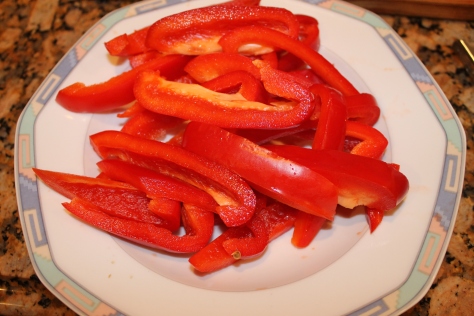For beginners, some of the cooking terms can be confusing and intimidating. For that reason, I have compiled a list of the BASIC ones, to make it easy for you to understand. Luckily for me, I have been in the kitchen long enough to know most of them, (except the baking terms). When you are following a recipe, this will help you understand the method of cooking. There are more terms that are used in Gourmet Cooking, such as Bechamel, but will save them for a future post.
Al dente: Pasta cooked until just firm. From the Italian “to the tooth.”
Bake: To cook food in an oven, surrounded with dry heat; called roasting when applied to meat or poultry.
Baking powder: A combination of baking soda, an acid such as cream of tartar, and a starch or flour (moisture absorber). Most common type is double-acting baking powder, which acts when mixed with liquid and again when heated.
Baking soda: The main ingredient in baking powder, baking soda is also used when there is acid (buttermilk or sour cream, for example) in a recipe. Always mix with other dry ingredients before adding any liquid, since leavening begins as soon as soda comes in contact with liquid.
Barbecue: To cook foods on a rack or a spit over coals.
Baste: To moisten food for added flavor and to prevent drying out while cooking.
Batter: An uncooked pourable mixture usually made up of flour, a liquid, and other ingredients.
Beat: To stir rapidly to make a mixture smooth, using a whisk, spoon, or mixer.
Blanch: To cook briefly in boiling water to seal in flavor and color; usually used for vegetables or fruit, to prepare for freezing, and to ease skin removal.
Blend: To thoroughly combine 2 or more ingredients, either by hand with a whisk or spoon, or with a mixer.
Boil: To cook in bubbling water that has reached 212 degrees F.
Bone: To remove bones from poultry, meat, or fish.
Bouquet garni: A tied bundle of herbs, usually parsley, thyme, and bay leaves, that is added to flavor soups, stews, and sauces but removed before serving.
Braise: To cook first by browning, then gently simmering in a small amount of liquid over low heat in a covered pan until tender.
Bread: To coat with crumbs or cornmeal before cooking.
Broil: To cook on a rack or spit under or over direct heat, usually in an oven.
Brown: To cook over high heat, usually on top of the stove, to brown food.
Caramelize: To heat sugar until it liquefies and becomes a syrup ranging in color from golden to dark brown.
Chop: To cut foods into small pieces in a fast motion using a chef’s knife. *
Core: To remove the seeds or tough woody centers from fruits and vegetables.
Cream: The butterfat portion of milk. Also, to beat ingredients, usually sugar and a fat, until smooth and fluffy.
Cube: To cut food into small (about 1/2- inch) cubes.
Cut in: To distribute a solid fat in flour using a cutting motion, with 2 knives used scissors-fashion or a pastry blender, until divided evenly into tiny pieces. Usually refers to making pastry.
Deep-fry: To cook by completely immersing food in hot fat.
Deglaze: To loosen brown bits from a pan by adding a liquid, then heating while stirring and scraping the pan.
Dice: To cut food into very small (1/8-to 1/4-inch) cubes.
Dollop: A spoonful of soft food such as whipped cream or mashed potatoes.
Dot: To scatter butter in bits over food.
Dredge: To cover or coat uncooked food, usually with a flour, cornmeal mixture or bread crumbs.
Dress: To coat foods such as salad with a sauce. Also, to clean fish, poultry, or game for cooking.
Drippings: Juices and fats rendered by meat or poultry during cooking.
Drizzle: To pour melted butter, oil, syrup, melted chocolate, or other liquid back and forth over food in a fine stream.
Dust: To coat lightly with confectioners’ sugar or cocoa (cakes and pastries) or another powdery ingredient.
Fillet: A flat piece of boneless meat, poultry, or fish. Also, to cut the bones from a piece of meat, poultry, or fish.
Fines herbes: A mixture of herbs traditionally parsley, chervil, chives, and tarragon, used to flavor fish, chicken, and eggs.
Flambé: To drizzle liquor over a food while it is cooking, then when the alcohol has warmed, ignite the food just before serving.
Flute: To make decorative grooves. Usually refers to pastry.
Fold: To combine light ingredients such as whipped cream or beaten egg whites with a heavier mixture, using a gentle over-and-under motion, usually with a rubber spatula.
Glaze: To coat foods with glossy mixtures such as jellies or sauces.
Grate: To rub foods against a serrated surface to produce shredded or fine bits.
Grease: To rub the interior surface of a cooking dish or pan with shortening, oil, or butter to prevent food from sticking to it.
Grill: To cook food on a rack under or over direct heat, as on a barbecue or in a broiler.
Grind: To reduce food to tiny particles using a grinder or a food processor.
Julienne: To cut into long, thin strips, matchsticklike in shape.
Knead: To blend dough together with hands or in a mixer to form a pliable mass.
Macerate: To soak in a flavored liquid; usually refers to fruit.
Marinate: To soak in a flavored liquid; usually refers to meat, poultry, or fish.
Mince: To cut into tiny pieces, usually with a knife.
Parboil: To partially cook by boiling. Usually done to prepare food for final cooking by another method.
Poach: To cook gently over very low heat in barely simmering liquid just to cover.
Purée: To mash or grind food until completely smooth, usually in a food processor, blender, sieve, or food mill.
Reduce: To thicken a liquid and concentrate its flavor by boiling.
Render: To cook fatty meat or poultry—such as bacon or goose—over low heat to obtain drippings.
Roast: To cook a large piece of meat or poultry uncovered with dry heat in an oven.
Sauté or panfry: To cook food in a small amount of fat over relatively high heat.
Scald: To heat liquid almost to a boil until bubbles begin to form around the edge.
Sear: To brown the surface of meat by quick-cooking over high heat in order to seal in the meat’s juices.
Shred: To cut food into narrow strips with a knife or a grater.
Simmer: To cook in liquid just below the boiling point; bubbles form but do not burst on the surface of the liquid.
Skim: To remove surface foam or fat from a liquid.
Steam: To cook food on a rack or in a steamer set over boiling or simmering water in a covered pan.
Steep: To soak in a liquid just under the boiling point to extract the essence—e.g., tea.
Stew: To cook covered over low heat in a liquid.
Stir-fry: To quickly cook small pieces of food over high heat, stirring constantly.
Truss: To tie whole poultry with string or skewers so it will hold its shape during cooking.
Whip: To beat food with a whisk or mixer to incorporate air and produce volume.
Whisk: To beat ingredients (such as heavy or whipping cream, eggs, salad dressings, or sauces) with a fork or whisk to mix, blend, or incorporate air.
Zest: The outer, colored part of the peel of citrus fruit.
* I added, Chop to the list, using my definition.
I hope you will find this list of cooking terms very handy and useful.
Happy Cooking in your Kitchen!
This list was provided by GoodHousekeeping.com
For additional culinary terms, please refer to this website: Culinary Ambition



Handy list for novice cooks following recipes…saves time!
LikeLiked by 1 person
Yes Angela! I am sure you are familiar with a lot of Italian cooking terms as well. 😊
LikeLike